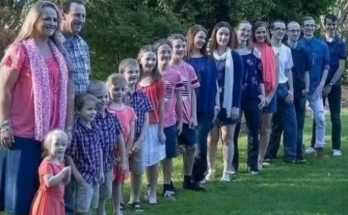 Title: The Peach Illusion: How Our Minds Play Tricks on Us
Title: The Peach Illusion: How Our Minds Play Tricks on Us
At first glance, the image in question sparks a double take—many people’s immediate reaction is to assume they’re seeing something highly inappropriate. The rounded curves, the central crease, and the darker circular area near the middle combine into a visual arrangement that closely resembles human anatomy. Yet, once the initial shock fades and the mind processes the details more carefully, the truth emerges: it’s not a risqué photograph at all, but rather the top of a peach, pit still intact, cleverly framed to trigger a misleading interpretation.
This type of phenomenon is a perfect example of pareidolia, the human brain’s tendency to perceive familiar patterns—especially faces, figures, or body parts—where none actually exist. It’s the same mental quirk that allows us to see animals in clouds, faces in tree bark, or silhouettes in the shadows. In this case, the peach has become an unwitting model for a cheeky optical illusion, making it a prime entry in the “innocent photos that prove you have a dirty mind” category.
Why does our brain jump to such conclusions so quickly? Part of the answer lies in evolutionary psychology. Human survival depended on quick recognition of important visual cues—detecting the presence of another person, recognizing expressions, and identifying potential mating opportunities or threats. Our brains developed an incredible ability to recognize human forms almost instantly. That same ability, however, can sometimes misfire, making us see something sexual or human-shaped in objects that have nothing to do with people.
Another factor is cultural conditioning. Society places a certain level of taboo and intrigue around anything sexual, meaning our brains are more likely to notice and latch onto shapes that resemble private body parts. That’s why these illusions are both surprising and amusing—our minds leap to a conclusion, and then the humor kicks in when we realize we were wrong. It’s a harmless reminder that perception isn’t always reality.
The creators of such optical illusion compilations know exactly what they’re doing. They rely on clever photography angles, strategic cropping, and objects that already share visual similarities with human forms. In the case of this peach, the lighting emphasizes the smoothness of the fruit, the pit creates a central focal point, and the orientation mimics a human pose from a very specific perspective. Without the stem or leaves in view to give away its identity, the illusion is remarkably convincing at first glance.
Beyond the humor, these images tap into deeper aspects of human cognition. The speed with which our brains interpret visual information is both a blessing and a source of error. Studies show that within milliseconds of seeing something, our brains create a “best guess” interpretation based on stored knowledge and past experiences. This is a survival mechanism—it allows us to react quickly—but it also means we sometimes misinterpret ambiguous images. In the case of this peach illusion, the brain’s rapid guess-making process leads directly to a wrong but funny conclusion.
Interestingly, the enjoyment we get from realizing the truth is also wired into our psychology. That moment of “Aha! I get it!” triggers a small release of dopamine, the brain’s reward chemical. It’s the same satisfying feeling we experience when solving a puzzle or getting the punchline of a joke. In this way, the peach illusion isn’t just a visual trick—it’s a tiny brain workout wrapped in humor.
Social media has amplified the popularity of such images. Platforms like Instagram, Reddit, and TikTok thrive on short, surprising content that prompts quick emotional reactions. An image like this can generate thousands of comments within hours, with viewers tagging friends to share the laugh. The format encourages playful banter, with people joking about how “their mind went straight to the gutter” before realizing it was just fruit. This viral quality shows how humor and mild embarrassment are powerful engagement tools online.
But there’s also a positive takeaway from this optical trick: it reminds us not to rush to judgment. In daily life, first impressions—whether about people, situations, or objects—can be misleading. Slowing down to take a second look often reveals a more accurate picture. In a way, this peach is a lighthearted metaphor for that lesson: things are not always what they seem, and reality is often much more innocent than our assumptions.
Of course, part of the fun comes from the fact that the illusion does, indeed, resemble something cheeky. That’s what makes it memorable. Without that striking resemblance, it wouldn’t hold our attention for more than a moment. The key to its charm is the balance between innocence and suggestiveness—a safe but naughty visual that walks the fine line between harmless humor and outright crudeness.
In art and advertising, similar techniques are often used to grab attention. Some brands have intentionally designed suggestive shapes into their logos or ads, banking on the idea that a viewer’s subconscious will make the connection and remember the image more strongly. The principle is the same here: our brains are wired to notice certain shapes, and once seen, they’re hard to unsee.
In conclusion, this peach illusion is more than just a giggle-worthy picture—it’s a fascinating case study in how our brains process visual information, how cultural cues influence perception, and how humor can arise from our own mental shortcuts. It also serves as a reminder that not everything that looks suggestive is actually inappropriate. Sometimes, it’s just fruit. But the fun comes from that split second when our minds leap to the wrong conclusion and we catch ourselves in the act.
That’s why “innocent photos that prove you have a dirty mind” will always be popular—they’re part optical illusion, part social game, and part self-aware humor. This peach might never have imagined it would be a star of internet culture, but in the world of visual tricks, even a humble piece of fruit can become a viral sensation.

